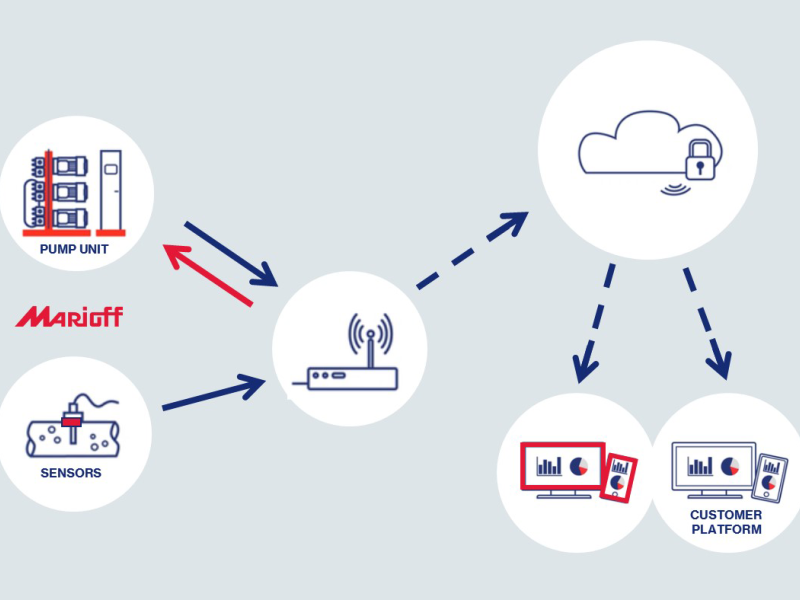In this digital era, data is recognised for its intrinsic value in smart decision-making and enhanced business insights. In manufacturing, data helps personnel on the shop floor to manage goals and tasks, understand details of work orders, and visualise critical conditions, such as machine configurations or engineering specifications. But, in the typical plant, access to real-time data is often a challenge. Workers, including managers, are seldom at a desk, rarely at one workstation, and seldom in an environment that is free of noise, extreme conditions, or potential hazards. These factors are among the many causing manufacturers to increasingly turn to mobile solutions and wearable technology to give workers access to the data they need—whenever and wherever the job takes them.
How wearables are evolving
Adoption is increasing at a phenomenal rate. MarketWatch projects the industrial wearable segment will grow from US$1.5 in 2017 to US$2.6 billion in 2023, a 73% jump, and that may be a conservative estimate.
Forrester predicted that by 2025, 14 million workers will use smart glasses and similar devices to increase performance. Mobile solutions and the use of voice-recognition will add more opportunities for expanding productivity in the plant where personnel need access to timely data the most.
Innovations are being seen in the devices used, such as glasses with drop-down mini display panels and hardhats equipped with screens. Software developers now are creating responsive designs that can scale and be viewed in small formats. Wearables can range from devices worn on the sleeve to a hardhat-mounted camera that projects real-time asset repairs back to the maintenance department’s senior technician.
Ruggedised tablets, constructed to withstand high heat, excessive moisture, and frequent bumps, are the most common remote devices used. Whether the company provides users with smart phones or has a bring-your-own-device policy, smart phones are often used in plants as the flexible, easy-to-use device for connecting to email, collaboration tools, and portals for fast access to relevant resources or knowledge bases.
Manufacturers can also turn to AI-driven “personal assistants” with Natural Language Processing (NLP) to allow users to access data and perform tasks without the need for a keyboard. This supports remote usage and applications when the user may appreciate hands-free convenience. Shipping, receiving, and warehouse personnel, who may be driving forklifts or scanning pallets, benefit from the ability to ask questions or enter data through voice commands, rather than typing.
Taking a closer look at the use-cases and benefits
Understanding the driving factors and influencing trends will help plant managers weigh pros and cons of investing in mobile and wearable technology. Thin margins and limited resources mean managers must be cautious about areas of investments, going forward with options they are confident will bring a fast Return on Investment (ROI).
When evaluating possible solutions and tools, it’s important to project savings that could come from the full range of benefits, including increased accuracy and productivity. For example, access to details on customer orders, design specifications, CAD drawings, and last-minute change orders will help ensure that customised products meet expectations. This increased accuracy, in turn, reduces waste from re-works and eliminates the high costs of customers rejecting shipments.
Use-cases for wearable technology and mobile applications continue to expand. Here are nine examples of when and where these technologies provide major benefits:
1. Role-based workbenches and dashboards. Modern ERP solutions often contain role-based workbenches and dashboards to help personnel manage their own Key Performance Indicators (KPIs), and ongoing responsibilities, whether maintaining safety stock levels, monitoring resources committed to Engineer-to-Order orders, or optimising supply chain deliveries for just-in-time strategies. Those tools only work, though, if they can be used when and where the user needs them. That could be on the shop floor, in the warehouse, or at the loading dock. Remote access through mobile or handheld devices is essential.
2. Empowering always-alert executives. Top managers of business units and the shop floor are often vigilant watchdogs. They want to stay connected 24/7 to real-time status alerts, especially when the plant runs three shifts or has global operations in different time zones. Portals for remote access for personnel and partners are increasingly important as global operations, work from home policies and outsourcing business models are more widely adopted.
3. IoT data where it counts. Manufacturers are increasingly embedding sensors in machinery and capturing performance and maintenance-related data points through Internet of Things (IoT) technology. It’s logical that maintenance managers and technicians have access to the data near the machine. As the user approaches the piece of equipment, a real-time diagnostic view of the machinery and its components can appear on a hand-held device. The screen can highlight key performance stats and red-flag any anomalies requiring attention, giving the technician the vitals needed to perform any necessary maintenance or repairs quickly.
4. Training and onboarding. As the shortage of skilled workers continues to plague manufacturing, often less experienced, junior-level candidates are brought on board, requiring extensive in-plant training. The complexity and high value of machine assets make plant managers reluctant to assign inexperienced technicians to perform maintenance on those assets. Augmented reality can be used for training, giving users the chance to visualise machine issues and “practice” engaging with the high-tech tools and repair tactics. This gives new recruits valuable experience.
5. Supervising remote workers. Video cameras mounted on hard-hats can also be used to support junior-level technicians in the field. The video can be streamed to a central location where a veteran technician provides advise and supervises activities remotely. This helps the new technician learn the “tribal knowledge” and speeds resolutions.
6. Faster resolution rates. Whether field service technicians are dispatched to customer sites or in-plant to perform maintenance or service, the timely access to asset details -- like service history, inventory of replacement parts, status of warranties or service agreements, and previous resolutions - will help technicians make well-informed decisions about repair vs. replace.
7. Upsell and replacement opportunities. Field technicians with access to account information and inventory details will be able to make in-field recommendations to customers and sell replacement or up-sell equipment on the spot—when the purchase decision is critical. Technicians, seen as trusted advisors, tend to have very high close-rates for on-site sales.
8. Tracking and monitoring personnel. Some plants can be massive, covering many buildings, yards, and warehouses. Assets can range from pipelines and rail lines, to rooftop exhaust scrubbers and barges for hauling raw resources. Personnel can be scattered over a wide vicinity. Some locations may also pose dangers. Wearables, like vests equipped with GPS tracking, can be used to help monitor location of employees, supporting safety and security, as well as encouraging productivity.
9. Speed pick-and-pack in the warehouse. Warehouse functions are some of the most relevant and valuable applications of wearable devices. Wrist-mounted, glasses-view, or dashboard-displayed screens help forklift drivers to find and fulfil orders quickly. Those loading and unloading trucks also appreciate the ability to confirm order numbers verbally rather than trying to type long series of digits accurately, often while wearing gloves and moving.
Final takeaways
As manufacturers strive to optimise resources and boost productivity, remote access to data is an important issue to be considered. Some tools are simple, such as equipping field technicians with mobile devices. Other applications, like AR for training, will provide more commitment of resources. Each specific use-case should be evaluated not only for the gains in productivity, but also the improved speed of service, enhanced customer experience, and improved quality control. Managers considering their wearable strategy should also keep in mind that the competition is readily adopting this technology and empowering their workers. Keeping pace with trends is important in today’s fast-changing manufacturing landscape.
Jarrod Kinchington is managing director for Australia and New Zealand at Infor. He has more than 20 years’ experience working closely with Business and IT stakeholders in a number of industries including telecoms, utilities, financial services and public sector.
By: Jarrod Kinchington, Managing Director, Infor ANZ






